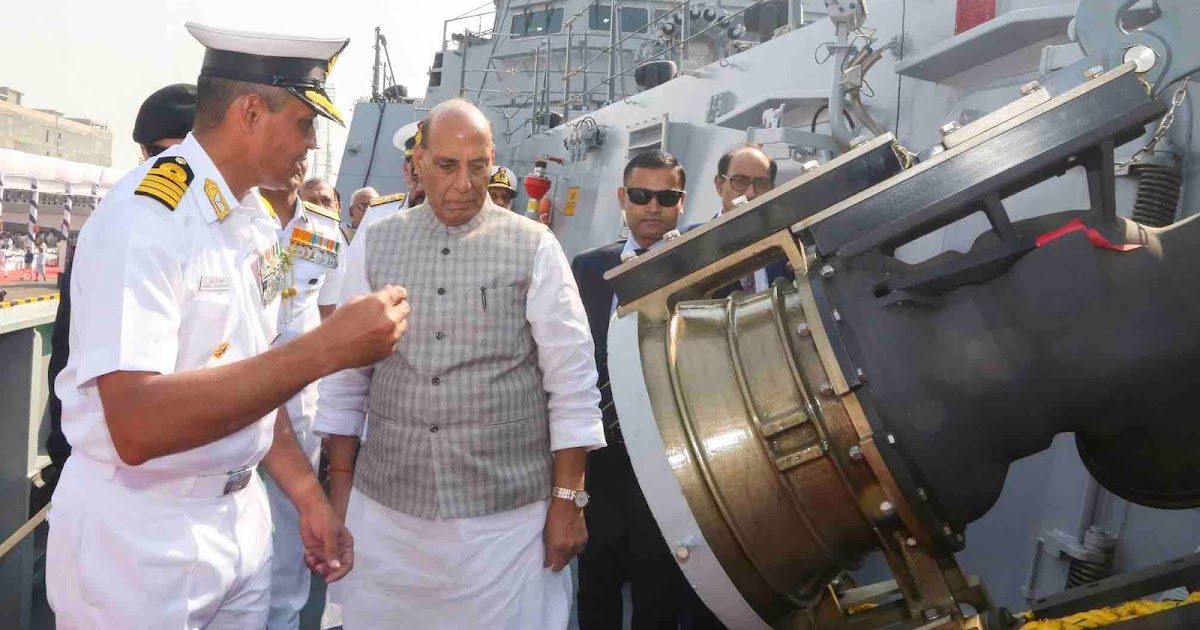
Navy Chief: will induct at least one Agniveer from each district, block and village
By Vikas Gupta
Defence News of India, 27th Dec 23
INS Imphal, the third of four indigenous ‘Visakhapatnam’ class destroyers, was commissioned into the Indian Navy on Tuesday by Defence Minister Rajnath Singh at the Naval Dockyard, Mumbai.
The four guided missile destroyers, built under Project 15B, were designed by the navy’s Warship Design Bureau and constructed by Mazagon Dock Shipbuilders Limited (MDL), Mumbai.
The navy chief, Admiral R Hari Kumar, said the fourth Project 15B destroyer, INS Surat, would be commissioned in 2024. Prior to the commissioning of INS Imphal, two Project 15B destroyers, INS Visakhapatnam and INS Mormugao, were commissioned into the Navy in 2021 and 2022 respectively.
INS Imphal is the first Indian warship named after a city in the north-east. The time taken to build INS Imphal has been the shortest for any indigenous destroyer. Its keel was laid on May 19, 2017 and the ship was launched on April 20, 2019. It sailed for her maiden sea sortie on April 28, 2023, and is being delivered on October 20, 2023 after completing sea trials in less than six months. The ship has a total crew complement of 315 personnel,
Describing the new warship as a shining example of ‘Aatmanirbharta’ in defence, Rajnath Singh stated: “INS Imphal is a symbol of India’s growing maritime power and it will strengthen it further. It will bolster our principle of ‘Jalmev Yasya, Balmev Tasya’ (One Who Controls the Sea is All Powerful) in the Indo-Pacific region.”
Describing INS Imphal as a conglomeration of the nation’s multiple strengths, the defence minister said: “Brahmos Aerospace installed Brahmos missiles on the ship. Torpedo tube launchers are of Larsen & Toubro (L&T). The Rapid Gun Mount has been installed by Bharat Heavy Electricals Limited (BHEL), and Medium Range missiles by Bharat Electronics Limited (BEL). In addition, many start-ups and MSMEs are involved in its construction.”
Measuring 163 metres in length, 17 metres in breadth and displacing 7,400 tonnes, the new destroyers is amongst the most potent warships built in India. It is propelled by four powerful gas turbines, in a “combined gas and gas” (COGAG) configuration, and is capable of speeds in excess of 30 knots (55 kilometres per hour).
Reiterating the government’s equal emphasis on modernising all three Services, Rajnath Singh stating that earlier governments focused only on protecting the country from land-based threats. He pointed out that with the Himalayas in the north and Pakistan’s hostile behaviour in the west, India was an island country from the perspective of trade.
“India plays the role of a net security provider in the entire Indian Ocean region. We will ensure that maritime trade in this region touches greater heights. For this, together with our friendly countries, we will keep the sea lanes secure,” said Rajnath Singh.
The navy chief said the Navy aims to induct at least one Agniveer from each district, each block and each village of the country. “The strategy is to attract youth – both men and women – from every corner of the country, up-skill them when in service, certify their abilities through education institutions, inculcate a spirit of nationalism and ensure that they re-join the civil sector as invaluable assets. The vision is to percolate such a nationalistic workforce across the length and breadth of the country,” he said.
INS Imphal has enhanced stealth features, making it difficult for enemy radar to pick up. This is achieved through efficient shaping of hull, full beam superstructure design, plated masts and use of radar transparent material on exposed decks. Its state-of-the-art weapons and sensors include surface-to-surface and surface-to-air missiles, anti-submarine warfare (ASW) rocket launchers and torpedo launchers, ASW helicopters, radars, sonar and electronic warfare systems. The ship can fight under nuclear, biological and chemical warfare conditions.
This warship’s high indigenisation level of 75 per cent includes indigenous Combat Management Systems, Rocket Launchers, Torpedo Launchers, Integrated Platform Management System, Automated Power Management System, Foldable Hangar Doors, Helo Traversing system, Close-in Weapon System, and bow-mounted sonar.






